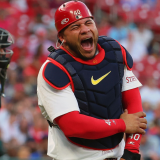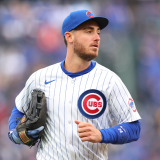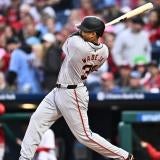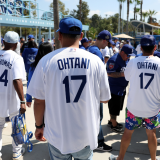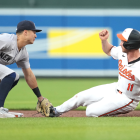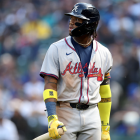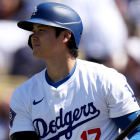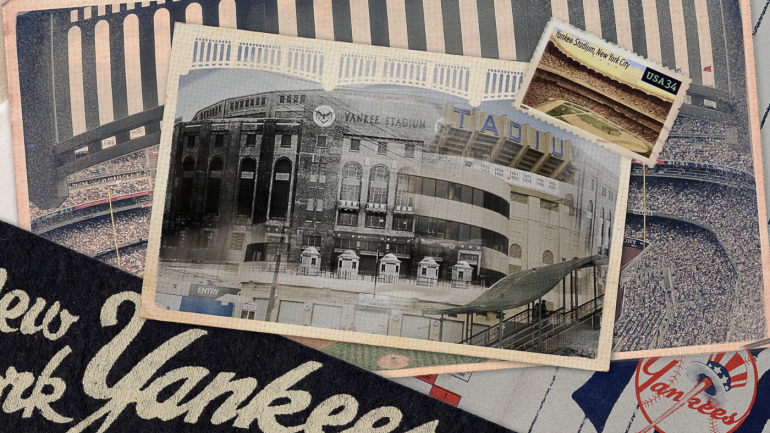
On April 18, 1923, it was a brisk 49 degrees in New York City, a spring in name only. The wind whipped up dust from the dirt roads and vacant lots abutting the ballpark that now rose from the planed-out soil of city plot 2106, lot 100. Those same winds whirled the eight-foot copper baseball bat that served as a weathervane from atop the in-play flagpole in center field. There had been a farm there, granted to John Lion Gardiner just prior to the Revolutionary War, and then a sawmill, and the surrounding sweeps of land seemed more suited to just that – an old farm or sawmill – rather than what now scraped the sky.
And what loomed above, three decks high, was a concrete-and-steel colossus unexampled in sports and certainly baseball. The forging of the stadium at 161st and River displaced 45,000 cubic yards of Bronx soil. Then it devoured 20,000 yards of concrete; four million feet of lumber; 800 tons of re-bar; 2,200 tons of steel beams and channels and angles and plates; 13,000 yards of topsoil and 116,000 square feet of Merion Bluegrass sod; one million screws of brass.
It was not the first stadium to be raised up in the medium of modern construction materials, but it was the most hulking, the most impossible-seeming. Unlike Wrigley, Fenway, Shibe, Crosley or others of the prior generation, Yankee Stadium defied words like "cozy" or "intimate" at every grand angle. In that way, it augured a coming era in which ballparks would no longer tuck into their existing neighborhoods but rather barge in with shoulders wide and arms akimbo. The original design of Yankee Stadium of course reflected some geographic limitations, but its final presence looked and felt like an unyielding one. Yankee Stadium was big and bad like its warrior-poet Babe Ruth – like its titular hometown nine soon would be – and it authored a reimagining: that the "ballpark" could be elevated and sprawled into the realm of "stadium." And so it was the first ballpark to be called a stadium.
Elevated train cars came and went, Ford Model T's queued along the roads, and the largest crowd in baseball history at that time swarmed the turnstiles well in advance of the 3:30 start time. The official capacity was 58,000, but in those days fire codes were either nonexistent or casually enforced, which allowed the attendance to swell to perhaps 70,000. After fire marshals at last turned away another 10,000 at the gates, ticket hawkers tacked on 15 cents to the $1.10 price of a grandstand seat and tried to move their wares while ducking police detectives tasked with stopping them.
Inside, the lucky ones saw the pecularities of the five-sided plot of land on which the Stadium stood sentry. The distance of the left-field pole was a meager 255 feet, but that was neutralized by the steep rise to 395 feet at the gate of the left-field bullpen and then from 474 feet in the alley to 500 feet in center. The other side, however, seemed to be an engraved invitation for Ruth: 255 feet down the right-field line to 367 in front of the bullpen gate to 423 in right center.
An overhang of the right-field bleachers created what would be known as "The Bloody Angle" – an intrusion into fair territory that abetted wild caroms and waking nightmares for right fielders. Those dimensions and the seating capacity would be altered over the years, and the Bloody Angle would be snuffed out prior to the 1924 season when the plate was moved in 13 feet. What those first fans saw, however, was an outfield layout that perhaps called to mind a cockeyed Polo Grounds, the park the Yankees had just vacated.
Encircling it all from above was an arresting frieze – made from 86,000 pounds of 22 gauge sea-green Toncan copper – that lined the roof and bore a flagpole between each arch. Builders added the flourish when team owners requested something that would add an "air of dignity" to the new ballpark. Fans and scribes would take to calling it the "facade," and it would come to be the architectural signature of Yankee Stadium.
Such a venue, which would anchor far more than "just" the mythic deeds of its baseball team, deserved no less. Yankee Stadium was, in its scale and the attractions housed within, the American Colosseum – with the obvious distinction that, unlike the Roman original, it no longer stands. Had it stood, though, then this would mark the 100th anniversary of the Stadium -- a golden occasion that cries out for fresh testimony to its rise, its eventual fall, and the numberless yet singular moments that belonged to it in between.
Year by year, month by month, and day by day, this is the story of Yankee Stadium.
1901
Ban Johnson, president of the fledgling American League, recognizes the need for a New York-based franchise. He settles on relocating the Baltimore Orioles – of no historical connection to the current Baltimore Orioles – to New York City.
Early 1902
Johnson begins talks with Orioles manager John McGraw about relocating to New York. Early that season, McGraw secretly travels to New York to scout locations for a possible ballpark. However, McGraw's inability to secure a preferred site coupled with his frequent suspensions during the 1902 season leads to a falling out with Johnson. McGraw will later say Johnson informed him he would no longer be the team's manager after the shift to New York.
July 1902
McGraw finagles his way out of his Orioles contract and becomes manager of the National League's New York Giants. Around the same time, McGraw and Giants owner Andrew Freedman orchestrate a roster transfer of the Orioles' top players to the Giants. Johnson is forced to populate the Baltimore roster with a skeleton crew of players in order to finish the season. Two months later, Freedman will sell the Giants.
August 1902
The American League votes to fund startup costs for a New York franchise in an effort to complete the planned relocation from Baltimore in time for the 1903 season.
Late 1902
Desperate to find both a team owner and ballpark for the AL's New York franchise, Johnson is approached by Joseph Gordon, a figure in the coal business. Gordon says he knows of an available site for a ballpark, but before he is willing to divulge it and move forward he wants control of the New York franchise. Gordon also introduces Johnson to businessman Frank Farrell, who agrees to put up the money for the franchise. Seemingly out of other options, Johnson agrees to the proposal. Farrell will be the team's owner, and Gordon will serve as team president.
March 12, 1903
The Yankees' new owners lease a plot of land in Washington Heights from the New York Institute of the Blind for the sum of $10,000 per year. They will have just seven weeks to complete construction of a new ballpark in time for the 1903 home opener. In the event plans go awry, Johnson identifies an alternative plot of land in the Bronx that belongs to the Astor family. That plot will turn out to be the future site of Yankee Stadium.
March 14, 1903
The American League incorporates the Greater New York Baseball Association to run the freshly minted New York franchise.
Late April 1903
Construction on the new ballpark is completed at a rough cost of $275,000 – a lofty figure by the standards of the time. Because of its elevated location, the new venue will be known as Hilltop Park, and the team that calls it home will become informally known as the New York Highlanders. Hilltop Park is a wooden structure with a single deck and a seating capacity of 16,000.
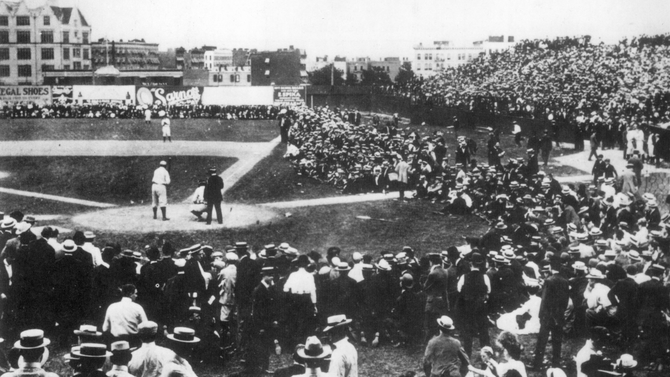
1909
In response to the rise of the modern, fire-resistant steel-and-concrete ballparks throughout the game, Farrell begins a search for land where such a structure could be built for his Highlanders. Hastening Farrell's mission is the increasing likelihood that the the New York Institute of the Blind will not extend the club's lease on the site of Hilltop Park. His search will eventually take him to a swath of marshland in the Bronx.
Spring 1911
Farrell offers to allow the nearby Giants to play home games in Hilltop Park while the Polo Grounds are rebuilt following a fire. Giants owner John T. Brush accepts the offer, and the Giants play their home games at Hilltop until near the end of June, when repairs to the Polo Grounds are completed.
Spring 1912
With the Highlanders' land lease nearing expiration, Brush and the Giants return the earlier favor by allowing Farrell's club to share the Polo Grounds, albeit at an initial cost of $55,000 per year. With expenses rising, additional money sunk into the project of surveying and preparing the site in the Bronx, and the team generally struggling, Farrell and his primary partner, former police chief William Devery, begin thinking of selling the club.
No longer playing home games at the physical heights of Hilltop Park that inspired the name "Highlanders," the team gradually becomes known as the "Yankees."
January 30, 1915
At the urging of Johnson, who wants more stability at the helm of the AL's New York franchise, Farrell and Devery finalize the sale of the club to Jacob Ruppert and Tillinghast L'Hommedieu Huston for the sum of $463,000 – roughly equal to $13.7 million today.
June 2, 1917
The Bronx site becomes a more attractive option when construction is completed on an elevated subway stop at 161st and River as part of the Interborough Rapid Transit's Woodlawn Line.
December 1919
The Yankees acquire ace-turned-historically-peerless-slugger Babe Ruth from the Red Sox in exchange for cash. To complete the transaction for Ruth, the Yankees send Boston owner Harry Frazee a $100,000 payment and also float him a $300,000 loan. It will stand as the most important and transformative trade in baseball history.
May 14, 1920
Concerned about the Yankees' rising fortunes and appeal since acquiring Ruth, Charles Stoneham, who purchased the Giants in 1919, and McGraw declare that starting with the 1921 season the Yankees will no longer be permitted to play their home games at the Polo Grounds. One week later and after meeting with Ban Johnson, Stoneham and McGraw walk back their pronouncement. However, Ruppert remains wary and steps up his efforts to find a location for a new Yankees ballpark.
Late September 1920
The Yankees sign a new lease that will keep them at the Polo Grounds through the 1922 season.
January/February 1921
The Osborne Engineering Company of Cleveland submits to the Yankees plans for a stadium that would roughly double the size of the current largest venue in the league, Braves Field in Boston. Ruppert and Huston approve the designs and intensify their search for a suitable location. The Osborne Company then begins surveying and inspecting a plot of land in the Bronx that abuts the Harlem River.
Late February 1921
Despite speculation in the press that the Yankees will build their new ballpark on the Upper West Side of Manhattan, the club announces it has purchased a site in the Bronx from the Astor Family where a sawmill presently resides. The sale price is $675,000. The site, via the Macombs Dam Bridge, is walking distance from the Polo Grounds.
Progress on the site and the stadium will be hindered by unforeseen circumstances and complicated by inflationary trends in the years following World War I. "The fans will soon forget about them over there," John McGraw declares.
April 18, 1922
The White Construction Company of New York is selected as the lead contractor for the project.
May 6, 1922
After delays of almost a full year, construction finally begins on the new stadium.
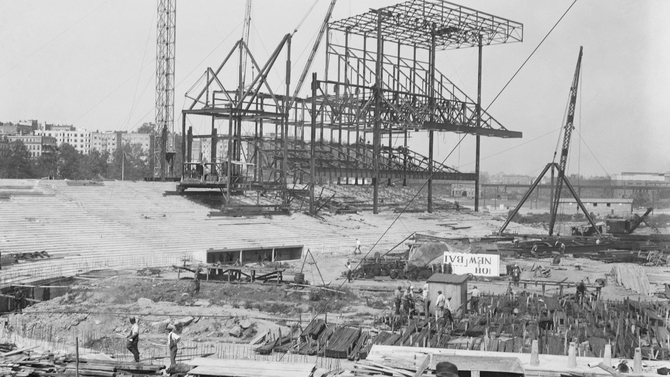
Spring 1923
After just 284 working days, construction on the massive Yankee Stadium is completed. In terms of its breadth, it is a first in baseball. It is the first baseball stadium with three decks and an electronic scoreboard. It's also the first major-league playing field to be encircled by a running path, which will later become MLB's first warning track. The seating capacity of 58,000 puts Yankee Stadium far above its peers of the day. It will remain the largest major-league baseball venue until Cleveland Municipal Stadium opens in 1931. The New York Times calls it "a skyscraper among ballparks." Fred Lieb of the New York Evening Telegram, who will eventually give the stadium the appellation "The House that Ruth Built," writes that, "Unlike the Polo Grounds, which is built in a hollow, the stadium can be seen for miles, as its triple decks grand stand majestically rises from the banks of the Harlem."
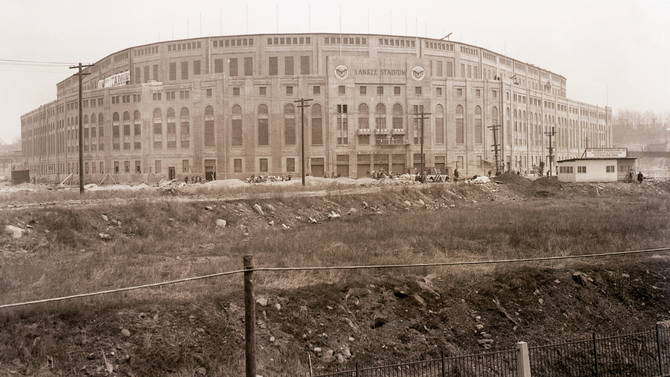
They can scarcely imagine what it would have been like if the original design plans, that called for the three decks to fully encircle the stadium and yield a capacity of 100,000, had been realized.
April 18, 1923
The first regular-season game played at Yankee Stadium begins at 3:30 p.m. local time. John Phillip Sousa is on hand to conduct the pre-game music, and New York governor Al Smith throws out the ceremonial first pitch to Yankees catcher Wally Schang. "Some ball yard," Ruth utters as he stands on the field surveying the unthinkable heights of the three concrete decks that spanned from the plate to each corner.
In the top of the second, Boston first baseman George Burns records the first hit in stadium history – a fly-ball single to short left-center. Yankees shortstop Everett Scott overcomes a spring ankle sprain to stretch his consecutive games played streak to 987 (his streak will eventually reach 1,307 and stand as the record until fellow Yankee Lou Gehrig breaks it). In the third inning, Ruth homers into the right-field bleachers that will become informally known as "Ruthville." Coming off a 1922 season that was somewhat disappointing by his impossibly lofty standards, Ruth before the first game at the new stadium proclaims that he'd give up a year of his life to hit a home run on Opening Day.
Bob Shawkey throws a complete game in the 4-1 Yankees win.
May 12, 1923
In the main event of the first slate of boxing matches held at Yankee Stadium, 42-year-old former heavyweight champion Jess Willard defeats Floyd Johnson when Johnson is unable to answer the bell for the 12th round. Yankee Stadium as a host for boxing had always been the plan. When the stadium was constructed, a 15-foot vault designed to house electrical, telephone, and telegraph wires was placed under second base for this reason.
May 21, 1923
Ruppert buys out Huston's share of the Yankees and becomes sole owner of the franchise.
Oct. 14, 1923
The inaugural season of Yankee Stadium also occasions the first World Series title in Yankees franchise history. In the 8-1 Game 5 win over the New York Giants that concludes the series, Bullet Joe Bush throws a complete game, and third baseman Joe Dugan registers four hits, including a home run. The Sunday afternoon contest in the Bronx lasts one hour and 55 minutes. The Giants had bested their crosstown rivals in the previous two World Series, but the 1923 breakthrough for the Yankees is the first of what will be 27 world championships for the franchise – the most in MLB by a cavernous margin.
Oct. 20, 1923
Syracuse edges Pittsburgh by a score of 3-0 in the first college football game held at Yankee Stadium. The leaning oblong that is the layout of the Yankee Stadium outfield makes it perfectly suited to host football games.
April 21, 1926
The Yankees' home opener begins a 39-year stretch that will see them lead the league in home attendance 26 times.
Oct. 8, 1926
The day after twirling a complete-game win in Game 6 of the World Series, 39-year-old Pete Alexander of the St. Louis Cardinals is summoned out of bullpen and into a two-out, bases-loaded jam in the seventh inning of the deciding Game 7. He strikes out Tony Lazzeri of the Yankees to preserve the Cardinals' 3-2 lead. Alexander – possibly drunk or hungover, according to legend – holds the Yankees hitless over the final two frames to preserve the win. It's the first World Series title in Cardinals franchise history. According to Cardinals catcher Bob O'Farrell, Alexander prior to being called upon to pitch in the tightest of spots was "tight asleep in the bullpen, sleeping off the night before, when trouble comes."
Sept. 30, 1927
Ruth turns around a 1-1 fastball from Washington Senators pitcher Tom Zachary and sends it deep into the right-field bleachers. With the blast, Ruth becomes the first player ever to hit 60 home runs in a season. The new single-season record will stand for more than three decades.
Oct. 8, 1927
The '27 Yankees, who went 110-44-1 during the regular season and bested the Athletics by 19 games in the American League standings, secure their standing as one of the greatest teams of all-time by completing a four-game sweep of the Pittsburgh Pirates in the World Series. During the regular season, the Yankee lineup deemed "Murderer's Row" hit 158 home runs. The remainder of American League teams averaged 40 home runs for the year – fewer than both Ruth (60) and Lou Gehrig (47) hit that season.
Winter 1927-28
The second and third decks at Yankee Stadium are extended into left field.
Sept. 9, 1928
A major-league attendance record is set when 85,265 total fans and 81,622 paying fans – each figure more than 20,000 in excess of capacity – turn out at the Stadum to see a doubleheader between the Yankees and Philadelphia A's. It marks the first time that the 80,000 attendance mark has been reached. Ten future Hall of Famers play or manage in the doubleheader, and the total attendance record set in this game will stand until 1954.
Nov. 10, 1928
In front of 85,000 fans at Yankee Stadium, Notre Dame defeats Army 12-6 in their annual football game. The 1928 edition features a second-half comeback by Notre Dame following head coach Knute Rockne's "win one for the Gipper" halftime speech. "The Gipper" was George Gipp, an All-American halfback who played for Notre Dame until he died from pneumonia not long after the 1920 season. As the story goes, Gipp in his final moments rasped to Rockne, "Someday, Rock, when things on the field are going against us, tell the boys, Rock, to go out and win just one for the Gipper."
May 19, 1929
A sudden thunderstorm leads many of the 9,000 fans in the right-field bleachers of Yankee Stadium to stampede for the exit. Two fans are crushed to death and 62 are injured in the chaos.
July 5, 1930
The Negro Leagues come to Yankee Stadium for the first time when Ruppert allows the Lincoln Giants and Baltimore Black Sox to use the venue free of charge for a benefit doubleheader. The highly successful exhibition raises more than $3,500 in support of the Brotherhood of Sleeping Car Porters. The fledgling union represents Black service workers on passenger trains and will eventually become a pioneering force in the American labor movement under A. Philip Randolph, who will go on to become the first Black vice-president of the American Federation of Labor.
An advertisement for a double-header between the New York Lincoln Giants and Baltimore Black Sox. July 5, 1930 @ Yankee Stadium.
— Alex Cheremeteff (@AlexCheremeteff) March 2, 2018
(The Lincoln Giants were managed by the legendary Pop Lloyd.)
TICKETS ON SALE AT: The Brotherhood of Sleeping Car Porters Headquarters. pic.twitter.com/YsBYoPkl02
Critical to the effort is esteemed Giants infielder and manager John Henry "Pop" Lloyd, who in 1930 is 46 years of age and in the waning days of his career. It is Lloyd's advocacy and reported friendship with Ruth that serves as the foundation for Black baseball's entree into Yankee Stadium. Writing in the New York Times some 80 years later, Lawrence D. Hogan declares of Yankee Stadium, "It essentially became the House That Ruth Built and Pop Opened."
On the summer Saturday in question, Lincoln's Bill Yancy, out early to shag flies, becomes the first Black player to step on the Yankee Stadium turf. His teammate Bill Holland soon after is the first Black pitcher to climb the Yankee Stadium mound. A third Giant, Chino Smith, becomes the first Black player to hit a home run at the Stadium. In another Yankee Stadium first, two Black umpires arbitrate the contests. Lloyd across the two games goes 4 for 8 with a stolen base and 24 putouts at first base.
The doubleheader marks the first two of what will turn out to be 225 games involving at least one Black team played at Yankee Stadium, almost all of them through 1948, when the demise of the Negro Leagues began in earnest. The Stadium would host benefits, exhibitions, regular-season contests when the primary tenants were on the road, most of the New York Black Yankees' home games, and even Negro League World Series games – all while Major League Baseball remained contemptibly segregated until 1947 and the Yankees themselves until 1955. Along the way, luminous Black ballplayers like Satchel Paige (he would notch 11 wins pitching at Yankee Stadium) and Josh Gibson (he would hit seven home runs there, including a towering shot in later in 1930 that some witnesses say left the stadium entirely) would grace the field and send the turnstiles spinning.
In the later words of historian James Overmyer, "Yankee Stadium ranks with Chicago's Comiskey Park, home of the annual Negro Leagues East-West All-Star game, as the most important White major-league venue for Black ball."
May 30, 1932
A plaque honoring late manager Miller Huggins is erected in the Yankee Stadium outfield next to the flag pole in dead center. In the coming years, two more plaques – one for Lou Gehrig and one for Babe Ruth – will be added and thus establish what will be known as Monument Park. Those monuments will be in play and part of center field for more than a quarter century.
So prominent are the standing plaques that a number of Yankee fans come to believe that the honorees are actually buried in the outfield.
June 19, 1936
In the first of their two epic clashes in the ring, Joe Louis and Nazi-era Germany's Max Schmeling fight at Yankee Stadium. Schmeling stuns Louis with a 12th-round knockout and the first loss of his career.
The poet Langston Hughes, who attends the fight, will write of Louis' defeat: "I walked down Seventh Avenue and saw grown men weeping like children, and women sitting in the curbs with their head in their hands. All across the country that night when the news came that Joe was knocked out, people cried. No one else in the United States has ever had such an effect on Negro emotions – or on mine."
1936-37
Wooden outfield bleachers in the Yankee Stadium outfield are replaced with concrete seating, and the second and third decks are extended into right-center.
October 1937
The Copper & Brass Research Association in its latest bulletin declares the copper frieze atop Yankee Stadium to be the largest in the world.
May 30, 1938
For the second time in major-league history, more than 80,000 attend a baseball game. A crowd of 81,891 paid and 83,533 total fans witnesses a brawl between the Red Sox and Yankees that ensues when Yankees outfielder Jake Powell is drilled in the stomach by a pitch from Archie McKain. Powell and Boston player-manager Joe Cronin emerge as the chief combatants. After each is ejected, Powell and Cronin resume their hostilities under the stands while the game is ongoing. They will both be suspended for 10 games.
June 22, 1938
While the Yankees are playing a doubleheader in Cleveland, Yankee Stadium hosts the rematch between Louis and Schmeling. Louis avenges the earlier loss to Schmeling and retains boxing's heavyweight championship with a TKO two minutes and four seconds into the first round. In the course of the slaughter, Louis throws 41 punches to Schmeling's two. Around the world, an estimated 100 million listen to the fight on radio.
Aug. 27, 1938
Working on just two days of rest, curveballer Monte Pearson throws the first no-hitter at Yankee Stadium in a 13-0 win over Cleveland. The next day, John Drebinger of the New York Times will rhapsodize that the Cleveland lineup submitted to Pearson "like reeds before a high gale."
Oct. 9, 1938
The Yankees – helmed by veterans Lou Gehrig and Bill Dickey and 23-year-old center fielder Joe DiMaggio – complete a sweep of the Chicago Cubs and in doing so become the first team ever to win three consecutive World Series. The Yankees will stretch the championship streak to four straight the following year. The '39 club will be remembered as one of the greatest ever despite minuscule contributions from Gehrig, who is by then heavily diminished by the neurological disease that will eventually take his life and bear his name.
Jan. 13, 1939
Ruppert dies at the age of 71.
April 20, 1939
Twenty-year-old Red Sox outfielder Ted Williams makes his major-league debut in the Opening Day contest between Boston and the host Yankees. New York prevails by a score of 2-0, and Williams goes 1 for 4 with a double.
July 4, 1939
More than 60,000 fans turn out for Lou Gehrig Appreciation Day. The famed first baseman, in the throes of a then-mysterious neurological disease that would claim his life less than two years later, is feted and presented with gifts before delivering his famous "luckiest man" speech.
July 11, 1939
Yankee Stadium hosts the All-Star Game for the first time. American League and Yankees manager Joe McCarthy stuffs his lineup card with six Yankees, including starting pitcher Red Ruffing and center fielder Joe DiMaggio. DiMaggio homers in the fifth en route to a 3-1 AL win.
The Stadium will later host the All-Star Game in 1960, 1977, and 2008.
1940s
At some point during the decade, the Yankees install a green curtain in center field. It is typically lowered while the home team is at the plate in order to provide an accommodating batter's eye, but it is often raised when the Yankees' opponents bat so as to give visiting hitters inferior visuals. This practice is stopped during home World Series games so that more tickets will be sold but otherwise continues into the 1960s.
May 30, 1940
For the third time, attendance for a Yankees game at the Stadium tops 80,000. A crowd of 82,437 watches the hosts split a doubleheader with the Red Sox.
May 15, 1941
After back-to-back hitless games, Yankees outfielder Joe DiMaggio lines a first-inning RBI single off Eddie Smith of the White Sox. DiMaggio's base knock at home marks the start of a hit streak that in the coming weeks will grow to unprecedented dimensions.
July 2, 1941
DiMaggio hits a fifth-inning home run against the Boston Red Sox to stretch his hit streak to 45 games and thus break Wee Willie Keeler's all-time record of 44 straight games with a hit. Earlier in the game, DiMaggio's brother Dom imperils the streak with a running snare that robs Joe of extra bases. DiMaggio's hit streak will eventually reach 56 games – a record that still stands.
Jan. 25, 1945
Del Webb, Dan Topping, and Larry MacPhail purchase the Yankees from Ruppert's estate for $2.8 million. MacPhail's unpredictable behavior and struggles with alcoholism will eventually force Webb and Topping to buy out his one-third share for $2 million.
April 30, 1946
In his first full season back from military service during World War II, Cleveland's Bob Feller holds the host Yankees hitless for the second of his three career no-hitters.
May 28, 1946
A crowd of 49,917 witnesses the first game played under lights at Yankee Stadium, a 2-1 loss to the Washington Senators. The centerpiece of a $600,000 renovation undertaken prior to the season, the arc lights wreathing the stadium provide illumination that, in the likely unscientific estimations of MacPhail, are equal to "5,000 full moons." Somewhat more plausibly, the New York Times posits that the 1,245 floodlights are enough to light up a four-lane highway that runs from the home of the Yankees to the home of the Senators.
The Yankees are the 13th of 16 MLB teams to install lights. The Cincinnati Reds were the first to do so in 1935, also under the guidance of MacPhail, but adoption of night baseball slowed during the years of World War II. In part, this is because some clubs and public officials, indulging in somewhat far-fetched hypotheticals, feared that lit-up ballparks filled with thousands of fans would make inviting targets should enemy bomber planes venture to the U.S.
Nov. 9, 1946
In a clash of the top-ranked teams in college football, Notre Dame and Army play to a scoreless tie. The game features a past Heisman Trophy winner (Army's Doc Blanchard in 1945) and three future winners (Army's Glenn Davis for this very season, Notre Dame's Johnny Lujack in 1947, and Notre Dame's Leon Hart in 1949). More than 76,000 attend the game that ends Army's 25-game win streak. One newspaper will headline its game story, "Much Ado About Nothing-Nothing." Notre Dame, who lost the previous two games against Army by a combined score of 107-0, will be named Associated Press national champions for the 1946 season.
April 27, 1947
Yankee Stadium serves as the centerpiece for Babe Ruth Day celebrated across Major League Baseball. Brought low by the cancer that would rob him of his life in less than a year, Ruth during the pregame ceremony addresses the crowd of more than 60,000 in a gravelly voice. "There's been so many lovely things said about me," he concludes. "I'm glad I had the opportunity to thank everybody. Thank you."
Sept. 30, 1947
Game 1 between the Yankees and Brooklyn Dodgers at the Stadium marks the first time a World Series game is televised. The Yankees prevail 5-3 and eventually take the series in seven games.
June 13, 1948
The Yankees host another day in honor of Ruth, this one for the purpose of retiring his No. 3 and marking the 25th anniversary of the Stadium. It will be Ruth's final public appearance. At one point, the dying Ruth, in uniform for one final time, leans on a bat he'd borrowed from Bob Feller to use as a cane and absorbs the moment as best he can. Nat Fein of the New York Herald Tribune captures the image, and the following year "The Babe Bows Out" will win the Pulitzer Prize for photography.
"The Babe Bows Out" (1948) Pulitzer Prize winning photo by Nat Fein of New York #Yankees legend Babe Ruth during his last visit to Yankee Stadium. #MLB #WorldPhotographyDay pic.twitter.com/wm1STg4h1C
— Baseball by BSmile (@BSmile) August 19, 2019
Aug. 17-18, 1948
After Babe Ruth's death at the age of 53, his body lies in honor at Yankee Stadium for a two-day public viewing prior to his funeral mass at St. Patrick's Cathedral and burial in Westchester County.
April 17, 1951
Two franchise legends – outfielder Mickey Mantle and public-address announcer Bob Sheppard – make their major-league debuts at Yankee Stadium.
Sept. 28, 1951
Yankees right-hander Allie Reynolds twirls a no-hitter against the rival Red Sox. This effort paired with his earlier no-no on July 12 at Cleveland makes Reynolds just the second moundsman in MLB history to pitch multiple no-hitters in the same season.
July 19-26, 1953
While the team is on a road trip, the Jehovah's Witnesses hold a convention at Yankee Stadium. On the final day, more than 90,000 pack the stadium. Another 25,000 assemble in the parking lots around the Stadium, and still another 50,000 listen via radio at a "Trailer City" encampment set up 40 miles away in New Jersey.
Oct. 5, 1953
Playing at home, the Yankees under manager Casey Stengel edge the Dodgers by the score of 4-3 in the clinching Game 6 of the World Series. The win makes the Yankees the first and still only team to win five straight World Series. Second baseman Billy Martin plays the hero for the hosts with a ninth-inning walk-off single off Clem Labine.
Dec. 17. 1953
Webb and Topping sell the Yankee Stadium structure, property, and parking lots along with the Kansas City ballpark of the club's top farm team to Chicago businessman Arnold Johnson for $6.5 million and then lease it back from Johnson with a mortgage attached. This allows Webb and Topping to write off stadium rent payments. The series of paper transactions grows more labyrinthine when soon after Johnson sells the land on which Yankee Stadium sits to the Knights of Columbus and then leases it back from them.
November 1954
The business dealings between the Yankees and Johnson become even more complicated when Johnson purchases the Athletics from Connie Mack's family and relocates the franchise from Philadelphia to Kansas City. Soon after the purchase of the A's, MLB commissioner Ford Frick orders Johnson to divest himself of all Yankee Stadium holdings so as to eliminate any conflict of interest. Johnson complies in the sparest sense of the term by selling the stadium to John Cox, a business associate of long standing. That sale involves no written contract and will become an item of interest during Congress' 1957 inquiry into baseball's antitrust exemption.
In the first two-and-a-half years after Johnson's purchase of the team, the A's and Yankees will pair up for an inordinate number of trades that involve a total of 57 players. In all, the two teams will make 16 trades between the time Johnson purchased the club in 1954 and his death in 1960. Taken in the aggregate, these trades accrue to the Yankees' benefit by a large and perhaps curious margin.
April 20, 1955
Six days after breaking the Yankees' color line, catcher Elston Howard appears in his first home game. The Yankees do not integrate until eight years after Jackie Robinson's debut, and they're the 13th of 16 teams to add a Black player to the roster. A standout performer, Howard will go on to make 12 All-Star teams, and in 1963 he will become the first Black player to win the MVP award in the American League. In 1969, Howard will make history again when he becomes the first Black coach in the AL.
Sept. 21, 1955
In a title fight pushed back a day because of a hurricane warning on the East Coast, Rocky Marciano retains his heavyweight title with a ninth-round knockout of Archie Moore. The following April, Marciano will retire from boxing at age 32 and with a record of 49-0.
Oct. 4, 1955
The Brooklyn Dodgers best the Yankees 2-0 in Game 7 of the World Series at Yankee Stadium for the first and only championship the franchise will win before relocating to Los Angeles.
May 30, 1956
Yankees outfielder Mickey Mantle hits a memorable blast off Pedro Ramos of the Washington Senators. Using the bat of teammate Hank Bauer, Mantle hits the ball off the facade of the Yankee Stadium upper deck in right field – a mere 18 inches from clearing those scalloped arches and leaving the stadium entirely.
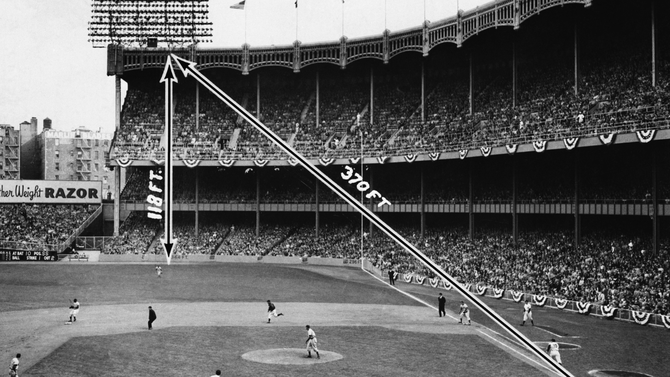
Oct. 8, 1956
In Game 2 of the World Series against the Dodgers, right-hander Don Larsen throws the first and still only World Series perfect game. A crowd of 64,519 beholds the feat at the Stadium, and by the late innings anywhere from 60 to 100 million tune in via radio.
Oct. 21, 1956
The NFL's New York Giants play their first home game at Yankee Stadium, a 38-10 win over the Pittsburgh Steelers. The Giants will call Yankee Stadium home until 1973.
Dec. 30, 1956
In the 1934 NFL Championship Game, the New York Giants mounted a surprising second-half comeback to defeat the Chicago Bears by a score of 30-13. Abetting that comeback was the team's decision to switch from cleats to sneakers at halftime – a change that afforded them much better traction on the frozen field at the Polo Grounds. The 1956 title game at Yankee Stadium again confronts the Giants and Bears with frozen turf, and this time the Giants play the entire game in Keds sneakers. Chicago also wears gym shoes instead of spikes, but theirs do not tame the icy conditions quite so well. "Those sneakers were better than ours," Bears coach Paddy Driscoll says after his team's 47-7 defeat. "Their soles were thicker than our soles. This helped their footing greatly."
July 20, 1957
An estimated crowd of between 90,000 and 100,000 attends a Christian revival led by famed evangelist Billy Graham at Yankee Stadium. Admission is free, and the event is televised by ABC.
Aug. 3, 1958
The Jehovah's Witnessess return to Yankee Stadium for their convention. The event, which is also held at the nearby Polo Grounds, draws a total of 253,922 attendees from 123 countries.
Dec. 28, 1958
The Baltimore Colts defeat the hometown New York Giants by a score of 23-17 in the NFL Championship Game. Alan Ameche's one-yard touchdown run in overtime gives the Colts the victory in what will be remembered as one of the greatest NFL games ever played. The game, which is the first overtime contest in league history and one of the first televised games, is widely credited with greatly increasing the NFL's popularity among fans.
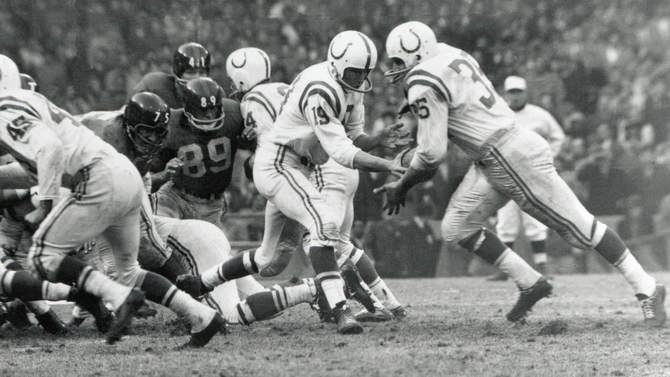
Nov. 20, 1960
Philadelphia Eagles linebacker Chuck Bednarik lays a devastating tackle on New York Giants running back Frank Gifford, which leaves him unconscious on the Yankee Stadium turf. Thanks to what later becomes known as "The Hit" in the sport's iconography, Gifford leaves the field on a stretcher misses the remainder of the 1960 season and all of the 1961 season.
The hit that knocked Frank Gifford out of football for over 18 months. RIP Chuck Bednarik. #Eagles pic.twitter.com/0ImR4Nk61h
— Rob Tornoe (@RobTornoe) March 21, 2015
Aug. 20, 1961
In the penultimate Negro Leagues All-Star Game ever played and the last sanctioned contest, the West squad defeats the East by a score of 7-1. Fifty-five-year-old Satchel Paige, who claims he's 52, combines with a pair of relievers for a one-hitter and is named MVP for the game.
Oct. 1, 1961
Roger Maris, the 27-year-old Yankees outfielder, breaks Babe Ruth's long-standing single-season record by hitting his 61st home run in the final game of the 1961 regular season. The history-making clout comes in the fourth inning against Boston rookie Tracy Stallard. Roughly 360 feet from the plate in Section 33 of the lower right field stands, 19-year-old Brooklyn resident Sal Durante catches the ball barehanded and is immediately escorted to safety by Yankee Stadium security. Later, he offers the ball to Maris, who tells Durante to keep the ball and sell it. Durante does so for the sum of $5,000 to a California restaurateur, who soon after gives the ball to Maris. Maris' MLB record will stand until 1998, when it's broken by Mark McGwire of the Cardinals. His AL record will stand until 2022, when Aaron Judge of the Yankees breaks it.
Oct. 28, 1962
New York Giants quarterback Y.A. Tittle equals an NFL record when he throws seven touchdown passes in a 49-34 win over the Washington Redskins.
Dec. 15, 1962
The short-lived Gotham Bowl ends its two-year run with Nebraska's taut 36-34 win over Miami. The 14-degree temperatures in the Bronx limit attendance to just more than 6,000.
Dec. 30, 1962
In the final NFL Championship Game played at the Stadium, the Green Bay Packers defeat the Giants by a score of 16-7.
May 22, 1963
Mantle hits a home that may surpass even his 1956 blast. In the bottom of the 11th of a 7-7 game, Mantle, hitting left-handed and using the bat of teammate Dale Long, uncoils on a high fastball from Bill Fischer of the A's.
Teammate Joe Pepitone will say he could "hear the boom" when the ball hit the arched facade at the very top of the ballpark, and onlookers will insist the ball Mantle smote was still rising when it hit that facade. If left unimpeded, the home run likely would have left the stadium entirely. Mantle will say it's the only ball he ever hit in which he could feel the bat bend in his hands.
Oct. 2, 1963
Lefty Sandy Koufax of the Los Angeles Dodgers sets a World Series record by striking out 15 Yankees in Game 1. The Dodgers will sweep the series, and Koufax's mark will stand until Bob Gibson of the Cardinals strikes out 17 Detroit Tigers in Game 1 of the 1968 World Series.
August 1964
The Yankees announce that Webb and Topping have sold the club to the Columbia Broadcasting System (CBS). Specifically, Webb and Topping sell 80 percent of the team to CBS for the sum of $11.2 million. Topping remains with the club as an operating partner. CBS installs in-house executive Mike Burke as team president.
Aug. 12, 1964
The switch-hitting Mantle against Chicago sets an MLB record by homering from both sides of the plate in a game for the 10th time in his career.
Oct. 4, 1965
More than 90,000 attend a Yankee Stadium pontifical mass conducted by Pope Paul VI. The gates of the Stadium open at 3:00 p.m. for the mass that begins more than five-and-a-half hours later.
June 10, 1966
Billed as "Soundblast '66," the first major concert at Yankee Stadium features acts like Ray Charles, the Beach Boys, Stevie Wonder, the Byrds, and the Guess Who, among others.
Sept. 19, 1966
Topping resigns from the Yankees and sells his remaining shares to CBS.
Sept. 22, 1966
A mere 413 fans show up at Yankee Stadium for a game against the White Sox. It will be the lowest attendance figure ever recorded for a Yankees game at the Stadium. Days later, the Yankees will finish in last place in the American League for the first time since 1912, when they were still known as the Highlanders.
May 14, 1967
On Mother's Day at the Stadium, Mickey Mantle drives a full-count changeup from Stu Miller of the Orioles into the right-field seats for his 500th career home run. Mantle is just the sixth player to reach the benchmark.
Sept. 20, 1968
Mantle homers for the final time at Yankee Stadium – this one a deep shot to right field off Boston's Jim Lonborg. Mantle's 266 regular-season home runs at the original Yankee Stadium stand as the record.
Aug. 17, 1970
At the annual Mayor's Cup exhibition between the Mets and Yankees, New York City mayor John Lindsay tells Mike Burke of the club's concerns about the Stadium, "Look, we've really got to do something for the Yankees."
In addition to the natural aging of the ballpark, the occasional "Bat Day" promotion, which began in the early 1960s and involves giving bats to young ticketholders arriving at the game, will be partly blamed for the current state of the Stadium. In particular, the regular pounding of the upper deck concrete with those Bat Day implements has hastened the structural degradation of Yankee Stadium.
Aug. 24, 1970
Burke writes to Lindsay and requests the city's assistance with one of three paths forward for the Yankees – a new domed stadium, a new open-air stadium, or – failing those two options – a substantially renovated Yankee Stadium. Around this time, Lindsay proposes providing the Yankees with the same amount the city spent on the construction of Shea Stadium for the Mets – somewhere between $25-30 million.
Oct. 2, 1970
Burke again writes to the Lindsay administration, this time to stress the importance of continuing to operate under an inexpensive lease at the Stadium.
March 1971
Mayor Lindsay announces that the city will spend $24 million to acquire Yankee Stadium and related assets, undertake upgrades, and then lease it back to the club for a period of 30 years.
August 1971
The New York Giants of the NFL announce plans to leave Yankee Stadium for a new facility in East Rutherford, N.J. The 1972 season will be the Giants' final one in the Bronx. They will play in Yale University's stadium and then Shea before Giants Stadium in New Jersey is completed in time for the 1976 NFL season. The Giants' decision to leave the city makes real the implicit threat that the Yankees will do the same in the absence of ballpark improvements.
Oct. 5, 1971
Burke writes to Lindsay and informs him that the cost to make the necessary refurbishments to the stadium and related properties will be at least $32 million. Around this same time, Burke floats the warning that, in the absence of a massive renovation to the Stadium, the Yankees will be forced to consider a move to Shea Stadium or the Meadowlands in New Jersey.
Dec. 7, 1971
The city's Board of Estimates votes to fund an engineering study that will determine the scope of work that the Stadium requires.
Dec. 9, 1971
In response to the City's flagging finances, Mayor Lindsay announces a moratorium on municipally financed construction projects save for projects already underway. As such, the Yankee Stadium renovation – barely two days old – is allowed to proceed under an allotted budget of $24 million to cover acquisition and construction costs.
March 1972
While $24 million remains the official budgeted figure, the Board of Estimate agrees to purchase and rehab the Stadium "whatever the cost." The Yankees soon after agree to a 30-year lease at the Stadium that will run through 2002.
Mid-1972
CBS chairman William S. Paley tasks Burke with finding a group of outside investors to purchase the Yankees. Burke soon begins discussions with a 42-year-old Cleveland shipbuilding executive named George Steinbrenner.
Jan. 4, 1973
Steinbrenner and his partners, which include Burke, complete the purchase of the Yankees from CBS for $10 million. Over the years, Steinbrenner will expand his ownership share of the Yankees, and that share will reach 70% before his death. "I won't be active in the day-to-day operations of the club at all," Steinbrenner pledges around the time the purchase is finalized.
April 1973
Mayor Lindsay publicly discloses that renovation costs have increased by $7 million. Around this time, Lindsay, who's in the final year of his final term, tells the New York Daily News, "By the time I retire the Stadium will be gutted and the project so far down the road it will be impossible to reverse it."
That same month, city comptroller Abe Beame, who will succeed Lindsay as mayor, estimates that the renovation will wind up costing around $53 million.
Sept. 23, 1973
The NFL's Giants tie the Philadelphia Eagles 23-23 in their final game at Yankee Stadium.
Sept. 30, 1973
The hosts fall to the Tigers by a score of 8-5 in the last game in Yankee Stadium before it closes for a sweeping complement of repairs and improvements. The Yankees for the next two seasons will share Shea Stadium with the Mets. After the game, home plate is presented to Babe Ruth's widow Claire, and first base is given to Lou Gehrig's widow Eleanor.
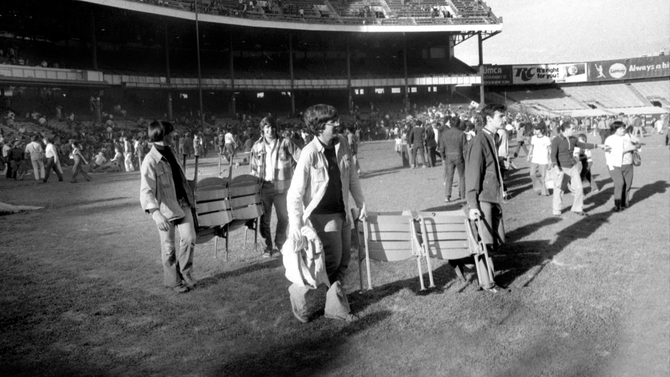
Nov. 16, 1973
The Board of Estimate approves an additional $16 million in funding toward the stadium project, which brings the current allotted total to roughly $40 million.
April 1974
Steinbrenner is indicted on 14 felony charges, many of which are related to his contributions to the re-election campaign of President Richard Nixon.
Late August 1974
Facing a possible sentence of six years in federal prison, Steinbrenner through his attorney works out a plea deal that allows him to avoid jail time.
November 1974
While renovations to Yankee Stadium continue, MLB commissioner Bowie Kuhn responds to Steinbrenner's legal troubles by suspending him from day-to-day team operations for a period of two years.
July 1975
Removal of the old green Stadium seats winds up damaging some concrete and adds another $1.1 million to the overall cost of the project.
December 1975
The New York Times reports that the cost of renovating Yankee Stadium has increased to almost $75 million, which isn't counting indirect expenses and lost revenues that themselves could add up to $150 million over the life of the lease.
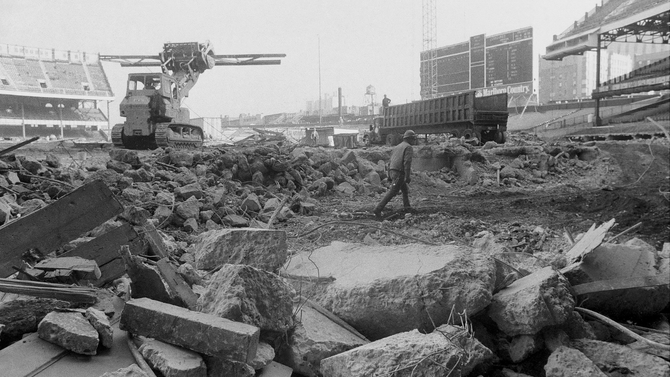
Dec. 6, 1975
The Yankees announce that the renovations to Yankee Stadium will be completed in time for the team's 1976 home opener against the Minnesota Twins on April 15. The Yankees also announce that 52 home night games have been scheduled for the 1976 season.
Feb. 13, 1976
The New York Cosmos of the North American Soccer League announce they will play the 1976 season at Yankee Stadium – a total of 12 regular-season home matches – before moving to Giants Stadium in East Rutherford, N.J. for the 1977 season. The highlight of their season in the Bronx comes later this year when Brazilian superstar Pelé, a true pantheon-dweller of the sport, scores one of his most memorable goals.
Pelé's bicycle kick against the Miami Toros in 1976. In the outfield at Yankee Stadium, he scored one of the most beautiful goals in the history of American soccer. RIP, O Rei. pic.twitter.com/4J4dR8kcln
— Pablo Iglesias Maurer (@MLSist) December 29, 2022
March 1, 1976
Kuhn reinstates Steinbrenner.
April 15, 1976
The newly and heavily renovated Yankee Stadium opens for business – on tax day, coincidentally – as the Yankees return to the Bronx for the home opener and thus end their two-year exile in Queens. The roughly $100 million, publicly funded project features a new exterior facade, escalators housed in three new exterior towers, a restaurant, seats expanded in width from 18 inches to 22 inches, the removal of 105 steel columns that once obstructed the views of ticket holders, a cantilevered upper deck, the installation of modern sodium-vapor lights, and a video screen spanning more than 500 feet in length and capable of providing instant replays of the on-field action. As well, the lower deck now has a higher slope for improved sightlines, and the capacity is shrunk by more than 10,000. Monument Park, which will soon begin growing its inventory of honorees, is moved off the field of play and behind the outfield walls. The arched frieze that once fringed the entire stadium is now confined to the area above the bleachers and made of precast concrete.
The team christens its new digs with an 11-4 win over the Minnesota Twins before a sellout crowd.
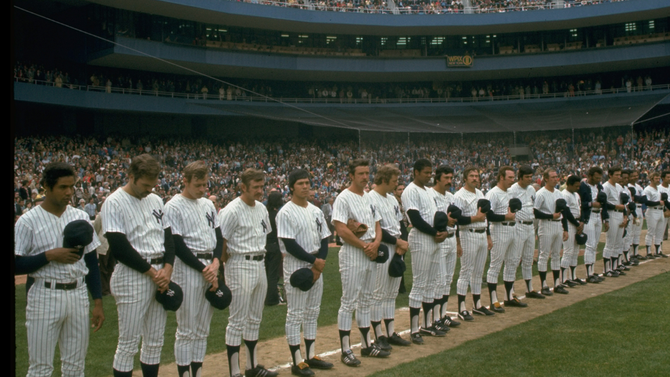
May 20, 1976
A brawl between the Yankees and Red Sox is touched off in the Bronx when Lou Piniella barrels into Boston catcher Carlton Fisk during a play at the plate. During the mayhem, Graig Nettles of the Yankees separates the throwing shoulder of Sox lefty Bill Lee, which will force Lee to miss almost two months. Afterward, Red Sox third-base coach Don Zimmer works the remainder of the game in a batting helmet as protection against objects being thrown from the seats.
Sept. 28, 1976
Legendary heavyweight boxer Muhammad Ali defends his title with a 15-round unanimous decision over Ken Norton. Thanks to Norton's dominance in the early rounds, the judges' decision will stand as one of the most controversial in boxing history.
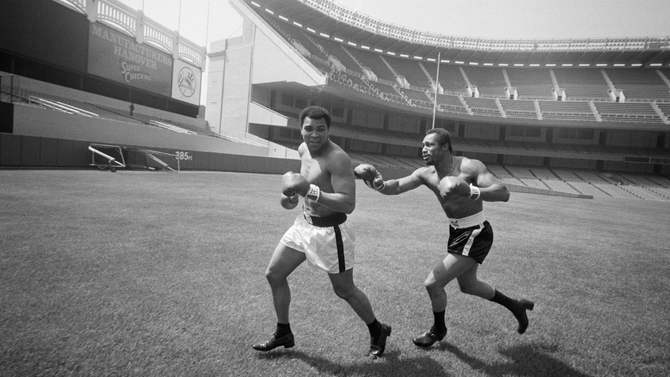
Oct. 2, 1976
The season finale, a doubleheader in the Bronx against Cleveland, makes it official that the Yankees in the first season at the renovated stadium lead the league in home attendance. They are also the only team in baseball to draw at least two million fans for the 1976 season.
Oct. 14, 1976
First baseman Chris Chambliss wins the Yankees' first pennant since 1964 with a ninth-inning walk-off home run off Mark Littell of the Royals. After the ball lands in the right-field seats, fans mob the field. Unable to touch home plate in the midst of all the chaos, Chambliss beats a hasty retreat to the clubhouse. He later returns to the field in a police raincoat and touches where home plate would have been (a fan had dug it up and taken it) with plate umpire Art Frantz looking on.
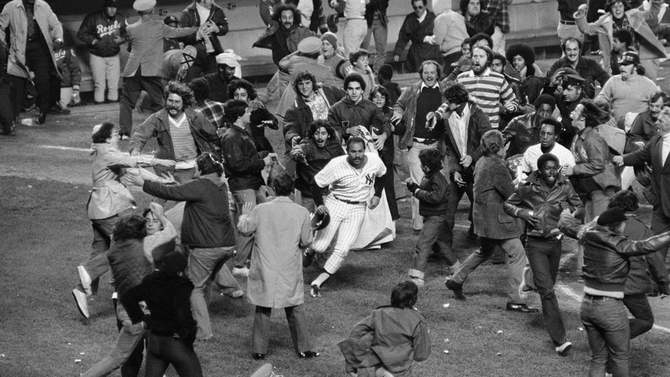
Feb. 3, 1977
Famed Negro Leaguer Pop Lloyd is posthumously elected to the Baseball Hall of Fame. While his superlative on-field accomplishments make him an obvious choice for the honor, Lloyd's plaque in Cooperstown also notes his central role in bringing Black baseball to Yankee Stadium. It reads in part that Lloyd was "Instrumental in helping open Yankee Stadium to Negro baseball in 1930."
Oct. 12, 1977
In an acute reminder that Yankee Stadium is not far removed from the ailments of the surrounding South Bronx, a fire starts in nearby Public School No. 3 roughly an hour before first pitch of Game 2 of the World Series. The ABC television cameras frequently cut away to the fire as it seems to creep closer to the ballpark. "There it is, ladies and gentlemen," TV broadcaster Howard Cosell memorably intones. "The Bronx is burning."
The fire, which would grow to five alarms before the Yankees' eventual Game 2 loss to the Dodgers, is one of the innumerable blazes that affflicted the borough during the 1970s – more than 40 per day during the peak. In the end, roughly 80 percent of Bronx housing stock is lost to fires in the decade, many of them acts of arson arranged by already neglectful landlords and building owners seeking insurance payouts.
Moments before the final out, Dodgers outfielder Reggie Smith is struck on the head and dazed by a rubber ball thrown from the upper deck in right field. He receives medical attention and then next day returns to Los Angeles in a neck brace.
Oct. 18, 1977
Yankees outfielder Reggie Jackson homers three times – on three swings – in the clinching Game 6 of the World Series against the Dodgers. His final blast, off knuckleballer Charlie Hough in the eighth inning, travels 475 feet to the blacked-out seats in distant center field. Jackson joins Ruth as the only sluggers to hit three home runs in a single World Series game. The win gives the Yankees their first title since 1962 and thus ends the franchise's longest championship drought since the Yankees won their first in 1923.
April 13, 1978
The Yankees' home opener also marks the debut of the "Reggie!" candy bar, which is named in honor of the slugger and 1977 World Series hero. Standard Brands, the maker of the chocolate-coated confection, hires models to pass out a free bar to each of the 44,667 ticketholders.
In the bottom of the first, Jackson crushes a Wilbur Wood knuckleball for a home run, and as he rounds the bases fans celebrate by throwing their Reggie! bars – thousands and thousands of them – on the field. The game is delayed for several minutes while the Yankee Stadium grounds crew cleans them up.
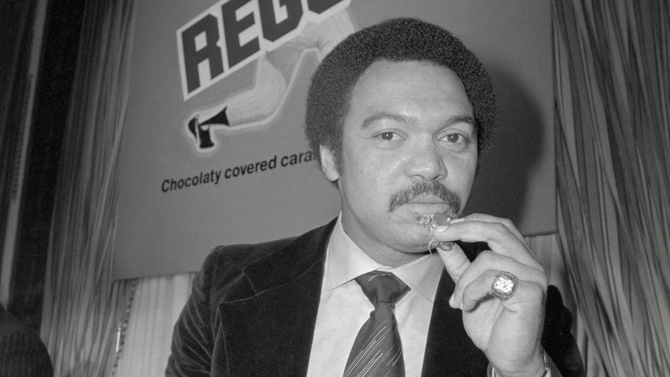
Oct. 14, 1978
Game 4 of the World Series against the Dodgers features a pivotal play that will come to be informally known as the "Sacrifice Thigh." In the sixth inning with the Yankees trailing by a score of 3-1 and runners on first and second with one out, Lou Piniella thumps a low liner that L.A. shortstop Bill Russell is able to knock down. Russell recovers in time to get the force at second, but his throw to first bounces off the leg of Reggie Jackson, who's trapped between the bases. The ball bounds away, and Thurman Munson is able to score from second. The Dodgers protest that Jackson intentionally got in the way of Russell's throw, but umpires allow the play to stand. The Yankees eventually tie the game and win in extras to even the series at 2-2. The next day, one New York daily will refer to Jackson's play as a "subtle illegality."
Oct. 15, 1978
Following a 12-2 comeback drubbing in Game 5 of the World Series that is punctuated by several fielding miscues, a number of Dodgers seem to blame the Stadium for their dismal performance. Russell after booting multiple ground balls gripes that "with 56,000 screaming people out there, it's hard to concentrate … The fans are the worst. The city is the worst."
"I don't like the park, I don't like the town," says L.A. outfielder Rick Monday. "I don't understand their way of life."
Reggie Smith, subjected to similar behavior in the 1977 World Series, says fans in the bleachers targeted him with "filthy language" and even threw fruit, rolls of toilet paper, and a tennis ball at him.
"The Yankees keep coming back," L.A. captain Davey Lopes says. "Maybe the city's got something to do with it. You get rats cornered and they fight back."
The Yankees close out the series with a win at Dodger Stadium in Game 6.
March 1979
The City, which has owned Yankee Stadium since 1973, begins work to seal cracks in some expansion joints at the Stadium.
August 1979
Pursuant to the March repairs, the city commissions a study to assess the deterioration of original concrete and expansion joints at Yankee Stadium. Unknown is whether the original construction or the rehab work earlier in the decade is to blame for the premature structural concerns. "After the analysis is done, it's likely somebody will be sued," New York City Commissioner of Parks and Recreation Gordon J. Davis says at the press conference announcing the $225,000 study.
Aug. 6, 1979
The day after the stunning death of All-Star catcher Thurman Munson in a plane crash and hours after laying their captain to rest in his native Ohio, the Yankees win an emotionally fraught game over the Orioles by a score of 5-4. Outfielder Bobby Murcer, one of Munson's closest friends on the team, drives in all five Yankee runs.
Oct. 2, 1979
Pope John Paul II celebrates Mass at the Stadium in a call for global peace and justice. "There are many poor people of this sort around the world," he says to the crowd of 80,000 during the homily. "There are many in your own midst. On many occasions, your nation has gained a well-deserved reputation for generosity, both public and private. Be faithful to that tradition, in keeping with your vast possibilities and present responsibilities."
Sept. 20, 1980
The late Munson is honored in a ceremony at Yankee Stadium. His No. 15 is retired on this day, and he receives a plaque in Monument Park.
July 1982
New damage to concrete stairs and expansion joints at Yankee Stadium is discovered, and the city and team begin discussing necessary repairs. After some initial concern that the work would not be completed in time for the Yankees' first three scheduled home games of 1983, the Parks Department later informs the club that the repairs will be completed by the end of February. The city also agrees to lower the Yankees' rent payments by a commensurate amount if a small number of seats aren't available for sale by the start of the season.
Even so, Steinbrenner – perhaps genuinely concerned or, more likely, perceiving an opportunity – begins looking to make alternative plans for the Yankees home opener on April 11. He eventually settles on 80,000-seat Mile High Stadium in Denver with an eye toward New Orleans for additional "home" dates.
Oct. 7, 1982
Repairs at Yankee Stadium begin.
Nov. 10, 1982
As repairs continue on schedule, the Yankees make a surprise announcement that the home portion of their schedule for the 1983 season will indeed begin in Denver.
Jan. 10, 1983
Acting Justice Richard S. Lane of New York State Supreme Court puts a stop to the Denver plans when rules that the Yankees may not play the first three home games of the 1983 season anywhere else but Yankee Stadium. Steibrenner releases a statement in which he accepts the ruling but adds, "The only thing we can hope for out of this experience is that the Mayor and the city administration realize they have to operate their departments like good businessmen."
July 4, 1983
On the 53rd birthday of George Steinbrenner, lefty Dave Righetti pitches a no-hitter at home against the Red Sox on 132 pitches. Righetti's is the first Yankee Stadium no-hitter since Larsen's World Series perfect game in 1956. Righetti will later transition to the bullpen as the Yankees' closer and eventually become just the third pitcher ever to throw a complete-game no-hitter and lead the league in saves.
July 24, 1983
Kansas City Royals star third baseman George Brett hits an apparent two-out, two-run, go-ahead home run off Goose Gossage in the top of the ninth. However, Yankees manager Billy Martin protests that Brett's bat has more than the allowable amount of pine tar on it. After a brief caucus with his crew, plate umpire Tim McClelland measures Brett's bat by the long side of home plate and determines it has more than the permitted 18 inches of pine tar. He calls Brett out, which ends the game and leads to an explosion of rage by Brett. The Royals file a protest.
Aug. 18, 1983
After American League president Lee MacPhail overrules the umpiring crew and upholds George Brett's July 24 "pine tar" home run, the Royals return to Yankee Stadium to complete the game. Billy Martin protests the resumed game before the first pitch by claiming Brett did not touch all the bases following his disputed homer. Presumably anticipating Martin's gambit, umpire Davey Phillips reveals to the Yankee manager an affidavit, signed by every member of the original umpiring crew, attesting that Brett did indeed touch every base. Martin is soon thereafter ejected, and the Royals go on to win the resumed game by a score of 5-4.
Aug. 4, 1985
On Phil Rizzuto Day at Yankee Stadium, White Sox right-hander Tom Seaver shares the spotlight when he allows one run in nine innings and notches career win No. 300 in the same city where his career began as a member of the Mets in 1967.
Sept. 12, 1987
Central State defeats Grambling by a score of 37-21 in the Whitney M. Young Urban League Classic. It is to be the final college football game played at old Yankee Stadium.
Nov. 1, 1987
Steinbrenner and New York City Mayor Ed Koch, after more than a year of negotiations, announce that city and club have agreed to an extended lease that promises to keep the Yankees in Yankee Stadium through 2032. At an estimated cost of $90 million, the city pledges to construct a commuter-rail station near the Stadium and add luxury boxes and a parking garage.
The new agreement is reached just three days before a scheduled New Jersey referendum on the publicly funded construction of a baseball-only facility at the Meadowlands – a referendum that will fail resoundingly. Years later, Jon Hanson, former chairman of the New Jersey Sports and Exposition Authority, will tell the Bergen Record that prior to the vote he had in place a "handshake deal" with Steinbrenner to relocate the Yankees to New Jersey.
Despite the public show of unity, the agreement will remain unsigned by Steinbrenner because of the city's desire to receive a percentage of the club's still-nascent but soon-to-be-stratospheric cable-television revenues. The Yankees, in turn, prefer to pay a flat rate. This dispute will prevent the lease through 2032 from ever being fully executed.
June 21, 1990
Anti-apartheid activist and recently freed political prisoner Nelson Mandela visits Yankee Stadium at the outset of his 11-day tour of the United States. After appealing to the crowd for continued support in his struggle against apartheid in South Africa, Mandela slips into a Yankees jacket and hat. "You now know who I am," he says. "I am a Yankee."
June 22, 1990
Billy Joel becomes the first artist to be the sole performer at a Yankee Stadium concert. He sells out both shows of his two-night residency at the Stadium, and one of the performances is released on video.
July 30, 1990
MLB commissioner Fay Vincent permanently bans Steinbrenner from daily management of the club after an investigation reveals he paid a known gambler for compromising information on Dave Winfield, whom the Yankees had signed to a free-agent contract in December 1980.
July 24, 1992
Under intense pressure on a number of fronts and faced with an erosion of power and ownership support, Vincent informs Steinbrenner that his ban will be lifted on March 1, 1993.
March 1, 1993
Steinbrenner is reinstated as managing general partner of the Yankees.
“George II - George Steinbrenner Rides Back Into Baseball” (Sports Illustrated - March 1, 1993) #MLB #Yankees #History pic.twitter.com/fDiNh1Qi00
— Baseball by BSmile (@BSmile) March 1, 2019
One of his first acts upon returning is to conduct a poll of season-ticket holders. One of the questions asks what their reaction would be if the team moves out of the Bronx.
July 19, 1993
"If we can't get people in the seats we have to do something," Steinbrenner tells WFAN radio just prior to a pair of home series against the Mariners and Angels. "Let this be a test week."
Steinbrenner's remarks come in response to flagging attendance at Yankee Stadium and amid rumors that he's eyeing possible stadium locations in New Jersey, Manhattan, and Westchester County.
Sept. 4, 1993
Born without a right hand, lefty Jim Abbott becomes the seventh Yankee pitcher to record a no-hitter, as he holds Cleveland hitless for nine innings in a 4-0 New York win.
March 1996
Kansas City-based HOK, the architecture firm renowned for its expertise in stadium design and construction, conducts a study of four possible sites for a new stadium for the Yankees. HOK settles on the west side of Manhattan as the ideal location, albeit with underestimated costs.
April 1996
The Yankees and the city and state of New York release a report that estimates an adequate refurbishment of Yankee Stadium would cost more than $750 million. Around this time, New York City mayor Rudolph Giuliani proposes a $1.1 billion, 70,000-seat stadium and multiuse sports complex with a retractable dome on Manhattan's West Side.
May 14, 1996
Former Mets ace and current Yankee renaissance project Dwight Gooden throws a no-hitter against a powerful Mariners offense that will score almost 1,000 runs that season. Rookie shortstop Derek Jeter secures a Paul Sorrento pop-up for the final out. "I think this is the greatest feeling," Gooden says afterward, "especially because I did it in New York. With all I've been through and all the stuff that has gone on, this is the greatest feeling."
After completing the bid for history, Gooden flies to Tampa to be with his father as he undergoes open-heart surgery.
Oct. 9, 1996
In Game 1 of the ALCS against the Orioles, rookie shortstop Derek Jeter hits his first career postseason home run – a game-tying solo shot in the eighth inning. Aiding the moment is 12-year-old Jeffrey Maier of Old Tappan, N.J. As Jeter's arcing drive heads toward the right-field warning track, Maier reaches over the Yankee Stadium fence and catches the ball in his glove an instant before it very likely would have settled into the glove of Orioles outfielder Tony Tarasco at the base of the wall. Tarasco and Baltimore manager Davey Johnson argue vociferously that Jeter should be called out, but umpires let the play stand. The Yankees wind up winning the game in 11 innings and eventually claim the series in five games.
Oct. 26, 1996
The Yankees clinch their 23rd World Series title and first since 1978 with a 3-2 home win over the Atlanta Braves in Game 6 of the Fall Classic. In the postgame jubilance, veteran third baseman Wade Boggs crafts a memorable celebration when he rides around the perimeter of the field on horseback with an NYPD officer.
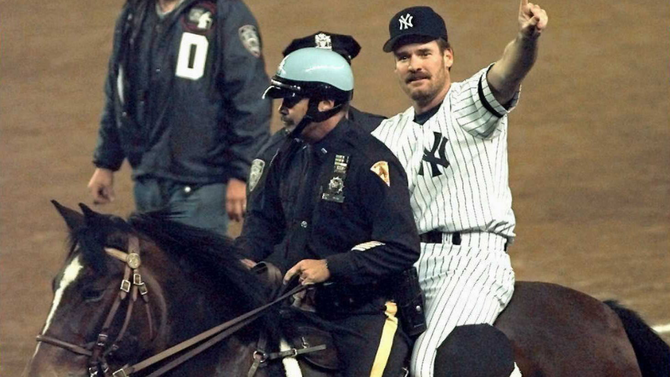
Soon after the trophy is hoisted, Steinbrenner again centers the stadium issue by pointing out to the press that the Yankees in their championship season were out-drawn by the Seattle Mariners.
April 13, 1998
At roughly 3 p.m. local time, a 500-pound beam at Yankee Stadium collapses and damages concrete and several seats along the third-base line. No one is injured. City officials close the Stadium for a full structural inspection, and a pair of home games against the Angels are postponed. The accident occurs mere days before the 75th anniversary of the Stadium's opening, and in response New York City mayor Rudolph Giuliani revists the idea of a ballpark for the Yankees in Manhattan – one heavily funded by the public. At the same time, Bronx borough president Fernando Ferrer parries the 1996 HOK call to build a stadium in Manhattan by proposing a "Yankee Village" sports-themed development around Yankee Stadium that would largely be funded by the city – albeit at a drastically lower public cost than a new Manhattan venue would require.
Late April 1998
Mayor Giuliani reveals plans for a new baseball-only stadium in Manhattan. Built on a platform near the Hudson River, the project, per media estimates, would cost between $750 million and $1.5 billion, funded almost entirely with public money. Not long after Giuliani's presentation, city comptroller Alan Hevesi promises to block any municipal bond offering that would fund a Manhattan stadium.
In response to Giuliani's initiative, City Council president Peter Vallone pledges to subject the project to a November public referendum, which would almost certainly end in defeat for Giuliani and Steinbrenner. Giuliani, in turn, attempts to force the referendum off the ballot via a little-used and obscure procedural maneuver.
April 30, 1998
The city's Independent Budget Office releases a 16-page study titled Double Play: The Economics and Financing of Stadiums for the Yankees and Mets. In it, researchers confirm that publicly funded stadiums yield little in the way of economic benefits for any public entity footing the bill. "While the limited economic benefits that would likely materialize may justify some expenditure of public funds, very substantial contributions from private sources – primarily the teams – would be required to make the new stadiums a fiscal winner for the New York City," the IBO's Chief Economist Ronnie Lowenstein says upon making the study public.
May 13, 1998
Following a Tuesday night game in which just more than 16,000 attended the first-place Yankees' home win over the Royals, Steinbrenner vents to the Daily News. "Why should we be sixth in the American League in attendance?" he queries. "You can't say we haven't put a good product on the field. I don't know if Mr. Ferrer was there Tuesday night, but maybe he can explain why they're drawing bigger crowds on the road than we are at home."
Absent Steinbrenner's complaints is context. As a spokesman for Ferrer, the Bronx borough president, soon pointed out, Tuesday's game took place after 12 straight days of rain in New York, in cooler spring temps, and before school is out for the summer. As well, Yankee ticket prices were the highest in the league by a wide margin – in most sections, more than two to three times as much as corresponding seats at Los Angeles Dodgers games.
May 17, 1998
Days after openly pondering retirement from baseball, beefy left-hander David Wells, soon to turn 35, spins a perfect game at the expense of the Minnesota Twins. It's the first Yankees perfecto since that of Larsen, who, coincidentally, attended the same San Diego high school that Wells did.
July 12, 1998
Upset by the prospect of a referendum, Steinbrenner, under a Daily News story headlined "The Boss Warns City: Don't Force Me Out," says the Yankees will move if funding for a new stadium is put to a public vote.
Oct. 7, 1998
Hours before the 114-win Yankees host Cleveland for Game 2 of the American League Championship Series, a state supreme court judge rules against Mayor Giuliani's efforts to stymie the referendum, thus allowing the public vote on a new Manhattan home for the Yankees to proceed.
As for ALCS Game 2, it turns out to be a 12-inning loss for the Yankees. The go-ahead Cleveland runs scores when New York second baseman Chuck Knoblauch suffers a mental lapse after covering first base on a bunt attempt. Rather than retrieve Tino Martinez's throw that had bounced off Travis Fryman, Knoblauch stays put and argues that Fryman should be called out for running out of the baseline. Meantime, Enrique Wilson is able to score all the way from first base and give Cleveland a 2-1 lead that they would eventually stretch to the final score of 4-1.
Luckily for Knoblauch, the Yankees will eventually prevail over Cleveland before sweeping the Padres in the World Series.
Oct. 16, 1998
An appeals court reverses the decision of the state supreme court judge, and the Yankee Stadium referedum is removed from the ballot. However, the effort to build the Yankees a new stadium in Manhattan will eventually come to grief for a variety of reasons, including funding complications and the unpopularity with the general public of relocating the franchise out of the Bronx.
Oct. 20, 1998
A subsequent appeal by the city council is dismissed.
July 18, 1999
David Cone, the veteran right-hander, throws the third perfect game in franchise history. The historic outing occurs on Yogi Berra Day, when the Hall of Fame catcher returns to the Stadium and thus ends his 14-year estrangement from the Yankees and Steinbrenner. As for Cone, it takes him just 88 pitches to retire those 27 Montreal Expos batters. At age 36, Cone becomes the oldest pitcher to throw a perfect game since Cy Young some 95 years earlier.
Sept. 27, 1999
The Detroit Tigers play their final game at Tiger Stadium. After the Tigers move into their new ballpark for the 2000 season, Yankee Stadium becomes the third-oldest park in the majors. It lags behind only Boston's Fenway Park and Chicago's Wrigley Field.
Oct. 22, 2000
In the second inning of Game 2 of the World Series between the Yankees and crosstown Mets, Yankees starter Roger Clemens almost touches off a brawl when he hurls a piece of broken bat at Mike Piazza that he retrieves after Piazza fouls off a pitch. Clemens will claim he mistook the bat fragment for the baseball.
Sept. 23, 2001
In a collective gesture of civic and national healing, "A Prayer for America" is held at Yankee Stadium to honor the heroes and victims of the Sept. 11 terrorist attacks that occurred just 12 days prior. Oprah Winfrey and James Earl Jones host an afternoon and evening of speeches, musical performances, and interfaith prayer.
Oct. 30, 2001
The 2001 World Series between the Yankees and Arizona Diamondbacks marks the first signature sporting event since the Sept. 11 attacks earlier in the year. Prior to Game 3 at Yankee Stadium, President George W. Bush throws out the ceremonial first pitch – the first time that a sitting president had done so since President Eisenhower before Game 1 of the 1956 World Series. Outfitted in a bulletproof vest and FDNY quarter-zip pullover, Bush throws an unforgettable strike to Yankees catcher Todd Greene and provides a touchstone moment of uplift for a city still so wounded.
Oct. 31, 2001
Because of an altered World Series schedule that is the result of those Sept. 11 attacks, Game 4 between the Yankees and visiting Arizona Diamondbacks becomes the first-ever MLB game played on Halloween. Shortly after midnight local time, Derek Jeter hits a walk-off home run to even the series at two games apiece. It's also the first MLB home run ever hit in the month of November.
The Yankees will notch another walk-off home run in Game 5 the next night back at Yankee Stadium – the first World Series game ever to begin in the month of November – but eventually fall in seven games to the Diamondbacks.
December 19, 2001
Two days before he leaves office, Mayor Giuliani announces plans to build new stadiums for the Yankees and Mets. Each venue will have a retractable roof, come at a cost of roughly $800 million, and be constructed near the site of the current ballpark. Under the proposal, the city would pay half of the total construction costs, and the state would make $150 million worth of infrastructure upgrades.
Early 2002
Shortly after taking office Mayor Michael Bloomberg, put off by the high level of public funding involved – particularly during an emerging economic downturn – scuttles Giuliani's plans via escape clause in the two stadium agreements.
Oct. 16, 2003
Future Yankees manager Aaron Boone sends the Yankees to the World Series and extends the title drought of the rival Red Sox by hitting a walk-off home run off Tim Wakefield in the 11th inning of ALCS Game 7.
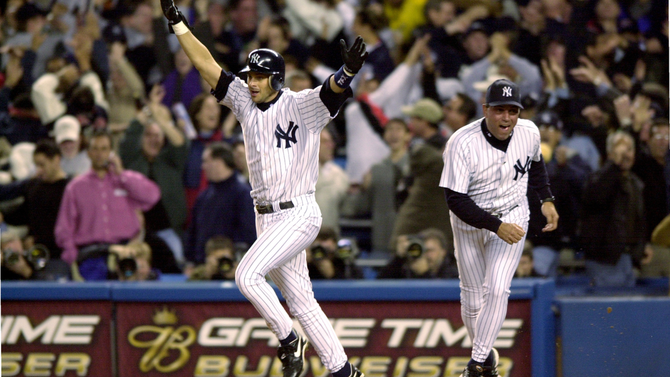
Oct. 25, 2003
In what is to the be the last World Series game ever played at the original Yankee Stadium, the Florida Marlins close out the Yankees with a 2-0 win in Game 6. Right-hander Josh Beckett secures World Series MVP honors with a five-hit shutout of the Yankees in the clincher.
Late July 2004
The Yankees, in collaboration with the Bloomberg administration and drawing from a 2004 proposal by Bronx borough president Adolfo Carrion Jr., begin to finalize plans to build a new ballpark in the Bronx at Macombs Dam and John Mullaly Parks. The plans also call for demolition of the existing stadium.
In a notable shift from prior rhetoric and saber-rattling, the Yankees commit to paying most of the associated costs. "The most recent proposal from the Yankees indicates a sea change in their thinking, recognizing that the public doesn't want to subsidize stadiums given the city's other more pressing needs," Harvey Robins, a former aide to Mayors Edward Koch and David Dinkins, tells the New York Times.
Oct. 20, 2004
The Red Sox defeat the Yankees 10-3 in Game 7 of the American League Championship series. The victory means that Boston becomes the first team in MLB history to come back to win a best-of-seven postseason series after being down three games to none. The Red Sox will sweep the Cardinals in the World Series and win the title for the first time since 1918.
June 15, 2005
The club announces plans to build a new ballpark just across the street from the current one. The new Yankee Stadium will be located to the north between 161st and 164th Streets, and Jerome and River Avenues.
Sept. 24, 2005
With one regular season game to go, the Yankees top four million in home attendance for the first time in franchise history. The final attendance figure of 4,090,696 is a new American League record. The Yankees will also top four million and set new AL records in 2006 and 2007.
Feb. 10, 2006
The New York City Department of Parks and Recreation releases an environmental impact statement on the proposed construction of the new stadium. At the outset, the report ticks off the reasons the existing Yankee Stadium is no longer requisite. To wit, the 8.5-acre footprint and structure size of 873,163 square feet are deemed inadequate for "the seating and service demand of a modern stadium." All of it, according to the report, means that "Yankee Stadium cannot comfortably handle attendance greater than 35,000; at that point, the hallways are crowded, long lines form for the food concessions and bathrooms, further interfering with pedestrian flow, and the kitchens and other support facilities are inadequate to meet the demand."
July 16, 2006
Yankees closer Mariano Rivera works the final two innings to preserve a slim lead over the visiting White Sox and becomes the first pitcher to record 400 saves for one team. In 2019, Rivera will be the first player to be elected unanimously to the Baseball Hall of Fame.
Aug. 17, 2006
A day after the formal groundbreaking, construction on new Yankee Stadium begins. Of the projected $1.3 billion price tag, the city of New York will contribute $135 million worth of waterfront parkland and $75 million toward parking facilities. The figures do not include various "hidden" expenses and opportunity costs. The work is scheduled to be done in time for the start of the 2009 season.
September 2007
In failing health, Steinbrenner relinquishes direct control of the team to his son Hal. Streinbrenner's other son, Hank, also takes on a leading role.
April 20, 2008
Pope Benedict XVI becomes the third supreme pontiff to lead Mass at Yankee Stadium. The 200th anniversary of the Archdiocese of New York occasions his visit.
July 14, 2008
At the 2008 Home Run Derby that is part of the All-Star festivities at Yankee Stadium, Josh Hamilton of the Texas Rangers sets a record with 28 homers in the first round, including one that journeys 518 feet. While Minnesota's Justin Morneau will win the event, Hamilton's jaw-dropping opening round stands as perhaps the most memorable performance in Derby history.
Sept. 21, 2008
Prior to the final game at the original Yankee Stadium, franchise legends are on hand, and fans are allowed on the field to walk the field a final time before the daughter of Babe Ruth throws out the ceremonial first pitch.
In the fourth inning, Yankees catcher José Molina hits the final home run in Stadium history. In the bottom of the seventh, Jason Giambi tallies the final base hit at Yankee Stadium. Although the game is not close enough for a save situation, Mariano Rivera fittingly secures the final three outs.
After the Yankees' 7-3 win over the Orioles, team captain Derek Jeter addresses the crowd. "We are relying on you to take the memories from this stadium, add them to the new memories to come at the new Yankee Stadium, and continue to pass them on from generation to generation," he says.
The Yankees will miss the postseason for the first time since 1993.
April 16, 2009
The new Yankee Stadium opens with the team's 10-2 loss to Cleveland. Around this same time, preparations for the demolition of old Yankee Stadium are being made. Seats and other items fit for sale as memorabilia are removed, and scaffolding is set up.
Nov. 7, 2009
The demolition of old Yankee Stadium begins with the razing of the bleachers. The process will be a lengthy one. Given the proximity of the stadium to street and sidewalk traffic, nearby structures, and elevated train lines, the demolition work must proceed carefully and will be done without the aid of explosives. Instead, heavy machinery is used to tear down the structure by pulling portions of it inward. The methodical pace of the work and the slow-to-be-realized promises of new green space will be a source of frustration for those in the surrounding neighborhoods.
December 2009
Workers begin the dismantling of major portions of the stadium, and the gradual destruction of the ballpark is now visible from the outside.
May 13, 2010
The last standing piece of Yankee Stadium – the right field upper deck – comes down. Eighty-seven years and 25 days after it first opened, the Stadium is no more.
July 13, 2010
In Tampa, George Steinbrenner dies at the age of 80 after suffering a heart attack.
Complete sources: "April 1923: First Day at Yankee Stadium" by John Durant, Sports Illustrated, April 22, 1963; Babe's Place: The Lives of Yankee Stadium by Michael Philip Wagner; Ballparks.com; BallparksOfBaseball.com; "Baseball: Vincent grants March 1 return to Steinbrenner" by Murray Chass, New York Times, July 25, 1992; Baseball-Reference.com; "Black Baseball at Yankee Stadium: The House That Ruth Built and Satchel Furnished (with Fans)," by James Overmyer, Black Ball: A Negro Leagues Journal, Vol. 7; "Boss puts Yankees fans to test," Chicago Tribune, July 20, 1993; "Carved in Ice: Bears-Giants "Sneaker" Title Game" by Bill Jauss, Chicago Tribune, Dec. 28, 1996; Center for Negro Leagues Baseball Research; Clem's Baseball Blog; ConcertArchives.org; "Controlled Demotion" by Henry Petroski, American Scientist, May-June 2011; Decade of Fire, documentary film by Gretchen Hildebran, Vivian Vazquez, Vivian Vásquez Irizarry; The Diamond in the Bronx: Yankee Stadium and the Politics of New York by Neil J. Sullivan; "The Famous Copper Frieze," Manhattan.edu; FieldOfSchemes.com; "Giuliani Has Deal for Two Stadiums," by Christine Haughney, Washington Post, Dec. 29, 2001; The Glory of Their Times by Lawrence Ritter; Green Cathedrals by Philip J. Lowry; "The House That Giuliani Wants to Build" by Josh Getlin, Los Angeles Times, Aug. 20, 1998; "The House that Ruth Built and Pop Opened," by Lawrence D. Hogan, OurGame.mlblogs.com; "The House that Ruth Didn't Build," by Kevin Baker, New York magazine, Jan. 31, 2008; "Josh Gibson Blazes a Trail: Homering in Big League Ballparks, 1930-1946," by Alan Cohen, Baseball Research Journal, Fall 2020; "Judge Tells Yankees to Play 1983 Opener in Bronx, Not Denver" by E.R. Shipp, New York Times, Jan. 11, 1983; Ladies and Gentlemen, The Bronx is Burning by Jonathan Mahler; "The legacy of Joe Louis' loss to Max Schmeling on Juneteenth" by Ben Wyatt, The Guardian, June 19, 2021; "A Look Back: Eventual Islander Sal Durante caught Roger Maris' record-setting 61st home run ball – and became part of history" by Nick Regina, Staten Island Advance; MLB.com; ND.edu; "The Negro Leagues Discovered An Oasis at Yankee Stadium," by Lawrence D. Hogan, New York Times, Feb. 13, 2011; New York City Campaign Finance Board; New York Daily News archives; NFL.com; New York Times archives; "New York Yankees team ownership history" by Mark Armour and Daniel R. Levitt, Society for American Baseball Research; "News Release: New Stadiums for the Yankees and Mets?" Independent Budget Office, the City of New York, April 30, 1998; No Minor Accomplishment: The Revival of New Jersey Professional Baseball by Bob Golon; NYCSubway.org; "Real Estate: Double Play," Time magazine, Dec. 28, 1953; Reggie Jackson: The Life and Thunderous Career of Baseball's Mr. October by Dayn Perry; "Roger Maris hits his 61st home run" by Robert M. Gorman, Library of Congress; Shades of Glory by Lawrence D. Hogan; Sports Illustrated archives; StadiumsOfProFootball.com; Those Damn Yankees by Dean Chadwin; Time magazine archives; United Press International archives; "Valuing Trades Between the Kansas City A's and the New York Yankees" by Jeff Zimmerman, Royals Review; Vatican.va; Village Voice archives; Washington Post archives; The Watchtower online library; "Why the Yankees almost moved to New Jersey on multiple occasions" by Ryan Ferguson, RyanFerguson.co.uk, Dec. 16, 2021; The World Series by Josh Leventhal; Yankees Century by Glenn Stout and Richard A. Johnson; "Yankee Stadium" by David Bady, Lehman.edu; "Yankee Stadium Project Final Environment Impact Statement," New York City Department of Parks and Recreation, Feb. 10, 2006; Yankee Stadium: A Tribute by Les Krantz; "The Yankees? Trump Meadowlands theme park? Grand plans for the Meadowlands that flopped" by John Brennan, Bergen Record, Aug. 26, 2016.







